数据库原理英文简介
[数据库原理]【英文版】Chapter05
![[数据库原理]【英文版】Chapter05](https://img.taocdn.com/s3/m/8b2bc028b4daa58da0114a0a.png)
11
12
3
SELECT Statement
SELECT [DISTINCT | ALL] {* | [columnExpression [AS newName]] [,...] } FROM TableName [alias] [, ...] [WHERE condition] [GROUP BY columnList] [HAVING condition] [ORDER BY columnList]
6
History of SQL
In late 1970s, ORACLE appeared and was probably first commercial RDBMS based on SQL. In 1987, ANSI and ISO published an initial standard for SQL. In 1989, ISO published an addendum that defined an ‘Integrity Enhancement Feature’. In 1992, first major revision to ISO standard occurred, referred to as SQL2 or SQL/92. In 1999, SQL3 was released with support for objectoriented data management.
5
History of SQL
In 1974, D. Chamberlin (IBM San Jose Laboratory) defined language called ‘Structured English Query Language’ (SEQUEL). A revised version, SEQUEL/2, was defined in 1976 but name was subsequently changed to SQL for legal reasons. Still pronounced ‘see-quel’, though official pronunciation is ‘S-Q-L’. IBM subsequently produced a prototype DBMS called System R, based on SEQUEL/2. Roots of SQL, however, are in SQUARE (Specifying Queries as Relational Expressions), which predates System R project.
数据库系统原理(英文)-0--course introdu

.
8
PART 2 China Computing Curricula 2005/2008
China Computing Curricula 2005/2008
数据模型
概念模型(如:实体—联系模型)
面向对象模型(语义对象模型)
关系数据模型
IM4 关系数据库(核心) 知识点:
概念模式映射为关系模式
实体完整性与参照完整性
关系代数与关系演算
.
16
Body of Knowledge in Computer Science(cont.) —— Knowledge Topics in CS-IM信息管理
.
22
Body of Knowledge in Computer Engineering (cont.) —— Knowledge units in CE-DBS 数据库系统
CE-DBS
数据库 系统 (10)
DBS0 历史与概述 (1) DBS1 数据库系统 (2) DBS2 数据建模 (2) DBS3 关系数据库 (3) DBS4 数 据 库 查 询 语 言 (2)
IM9 物理数据库设计(选修) 知识点:
存储结构和文件结构 索引结构(顺序文件上的索引、辅助索引) B树 散列表 签名文件 稠密索引文件 变长记录文件 数据库效率和协调
.
20
Body of Knowledge in Computer Engineering
包括如下18个知识领域: CE-ALG 算法与复杂度 CE-CAO 计算机体系结构和组织 CE-CSE 计算机系统工程 CE-CSG 电路和信号 CE-DBS 数据库系统 CE-DIG 数字逻辑 CE-DSP 数字信号处理 CE-ELE 电子学 CE-ESY 嵌入式系统 CE-HCI 人机交互
unit1:数据库原理、sql(ddl、dml)
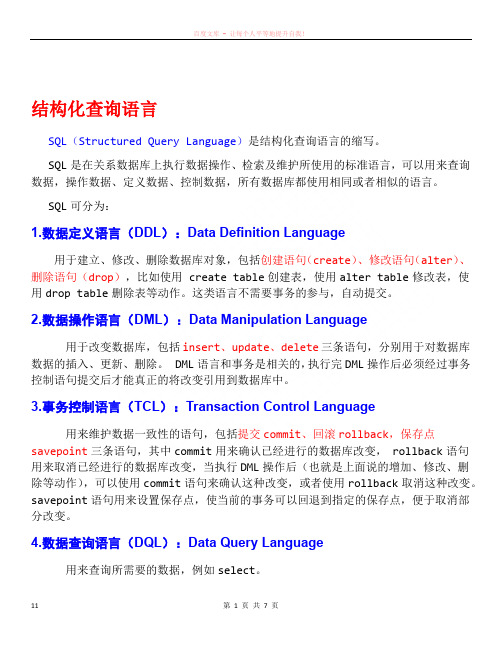
结构化查询语言SQL(Structured Query Language)是结构化查询语言的缩写。
SQL是在关系数据库上执行数据操作、检索及维护所使用的标准语言,可以用来查询数据,操作数据、定义数据、控制数据,所有数据库都使用相同或者相似的语言。
SQL可分为:1.数据定义语言(DDL):Data Definition Language用于建立、修改、删除数据库对象,包括创建语句(create)、修改语句(alter)、删除语句(drop),比如使用 create table创建表,使用alter table修改表,使用drop table删除表等动作。
这类语言不需要事务的参与,自动提交。
2.数据操作语言(DML):Data Manipulation Language用于改变数据库,包括insert、update、delete三条语句,分别用于对数据库数据的插入、更新、删除。
DML语言和事务是相关的,执行完DML操作后必须经过事务控制语句提交后才能真正的将改变引用到数据库中。
3.事务控制语言(TCL):Transaction Control Language用来维护数据一致性的语句,包括提交commit、回滚rollback,保存点savepoint三条语句,其中commit用来确认已经进行的数据库改变, rollback语句用来取消已经进行的数据库改变,当执行DML操作后(也就是上面说的增加、修改、删除等动作),可以使用commit语句来确认这种改变,或者使用rollback取消这种改变。
savepoint语句用来设置保存点,使当前的事务可以回退到指定的保存点,便于取消部分改变。
4.数据查询语言(DQL):Data Query Language用来查询所需要的数据,例如select。
5.数据控制语言(DCL):Data Control Language用于执行权限的授予和收回操作、创建用户等,包括授予grant语句、收回revoke语句、create user语句,其中grant用于给用户或角色授予权限,revoke 用于回收用户或角色已有的权限。
数据库系统原理,github
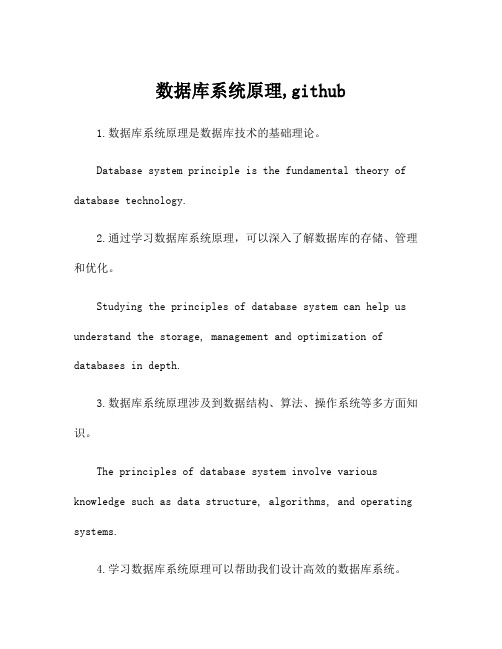
数据库系统原理,github1.数据库系统原理是数据库技术的基础理论。
Database system principle is the fundamental theory of database technology.2.通过学习数据库系统原理,可以深入了解数据库的存储、管理和优化。
Studying the principles of database system can help us understand the storage, management and optimization of databases in depth.3.数据库系统原理涉及到数据结构、算法、操作系统等多方面知识。
The principles of database system involve various knowledge such as data structure, algorithms, and operating systems.4.学习数据库系统原理可以帮助我们设计高效的数据库系统。
Studying the principles of database system can help us design efficient database systems.5.了解数据库系统原理能够提升我们在数据库领域的专业能力。
Understanding the principles of database system can enhance our professional skills in the field of databases.6. 《数据库系统原理》是一本经典的数据库教材。
"Database System Principles" is a classic textbook on databases.7.该书详细介绍了数据库系统的各个方面。
The book provides a detailed introduction to various aspects of database systems.8.通过阅读该书,可以系统地学习数据库系统原理。
数据库原理与应用英语
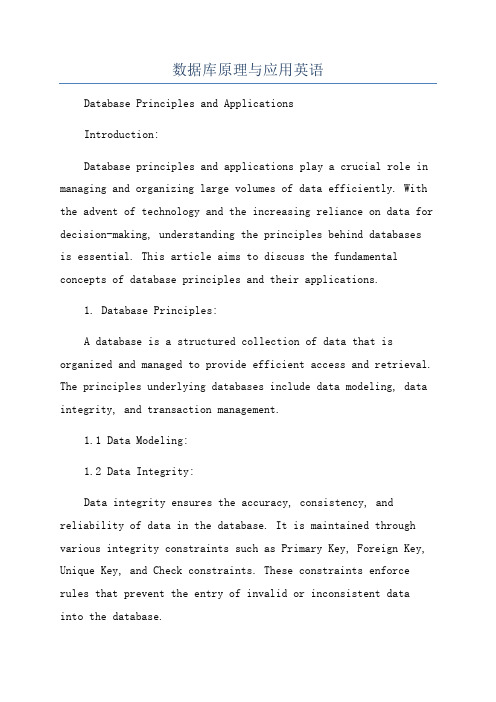
数据库原理与应用英语Database Principles and ApplicationsIntroduction:Database principles and applications play a crucial role in managing and organizing large volumes of data efficiently. With the advent of technology and the increasing reliance on data for decision-making, understanding the principles behind databases is essential. This article aims to discuss the fundamental concepts of database principles and their applications.1. Database Principles:A database is a structured collection of data that is organized and managed to provide efficient access and retrieval. The principles underlying databases include data modeling, data integrity, and transaction management.1.1 Data Modeling:1.2 Data Integrity:Data integrity ensures the accuracy, consistency, and reliability of data in the database. It is maintained through various integrity constraints such as Primary Key, Foreign Key, Unique Key, and Check constraints. These constraints enforce rules that prevent the entry of invalid or inconsistent datainto the database.1.3 Transaction Management:Transaction management ensures the atomicity, consistency, isolation, and durability (ACID) properties of database operations. Transactions represent a logical unit of work that can consist of multiple database operations. The database management system (DBMS) ensures that transactions are executed reliably and with proper concurrency control.2. Database Applications:2.1 Online Transaction Processing (OLTP):2.2 Decision Support Systems (DSS):2.3 Customer Relationship Management (CRM):CRM databases are used to store customer-related information such as contact details, purchase history, and preferences. CRM systems help organizations to manage customer interactions and improve customer satisfaction. They are widely used in sales, marketing, and customer service departments.2.4 Data Warehousing:Data warehousing involves the collection, integration, and storage of data from various sources for analysis and reporting. Data warehouse databases are designed to support decision-making processes by providing a consolidated and historical view of data. They are used in business intelligence, reporting, and data analytics.2.5 Geographic Information Systems (GIS):GIS databases store spatial data such as maps, satellite images, and geospatial information. They enable the integration and analysis of spatial data in various domains like urban planning, environment management, and logistics. GIS databases use specialized spatial indexing techniques to optimize queries based on location.Conclusion:In conclusion, database principles and applications form the foundation of efficient data management. Understanding the principles of data modeling, data integrity, and transaction management is crucial for designing and maintaining robust databases. Moreover, the applications of database principles are diverse, ranging from online transaction processing to decision support systems and customer relationship management. Mastering database principles and their applications is essential for professionals working in the field of data management and analytics.。
数据库系统原理英文111

Database System Concepts- Chapter1 Introduction - 3
§1.0 DB, DBMS, DBS(cont.)
DBMS provides an environment that is both convenient and efficient for store and retrieve information definition of structures for storage of information data manipulation mechanisms data safety mechanisms
Recordk
block1
block
Recordi
Block n
…
…
Physical File on disk Physical address: platter/track /sector
block1
blocki
…… …
Recordm
blockk
OS:file system and I/O subsystem
Database system (DBS) having the same definition as DBMS in the textbook the term DBS and DBMS are used interchangeably in the textbook
February 2011
February 2011
Database System Concepts- Chapter1 Introduction - 2
§1.0 DB, DBMS, DBS
Definitions in the textbook Database (DB) — a collection of interrelated data, stored in systems as files Database management system (DBMS) — DB, or a collection of interrelated data — set of programs to access the data in DB
[数据库原理]【英文版】Chapter01
![[数据库原理]【英文版】Chapter01](https://img.taocdn.com/s3/m/64df49c008a1284ac850430a.png)
Mei-Ling Shyu Department of Electrical and Computer Engineering University of Miami
Chapter 1
Introduction to Databases
Data Warehousing
Organizations now focus on ways to use operational data to support decision-making, as a means of gaining competitive advantage. However, operational systems were never designed to support such business activities. Organizations need to turn their archives of data into a source of knowledge, so that a single integrated / consolidated view of the organization’s data is presented to the user. A data warehouse was deemed the solution to meet the requirements of a system capable of supporting decision-making, receiving data from multiple operational data sources. The data warehouse integrates corporate application-oriented data from different source systems, which often includes data that is inconsistent. The integrated data source must be made consistent to present a unified view of the data to the users.
ch1-数据库系统原理课件(英文版)

Difficulty in accessing data
Data isolation — multintegrity problems
Integrity constraints (e.g. account balance > 0) become ―buried‖ in program code rather than being stated explicitly Hard to add new constraints or change existing ones
Purpose of Database Systems
View of Data Database Languages Relational Databases
Database Design
Object-based and semistructured databases Data Storage and Querying Transaction Management Database Architecture Database Users and Administrators Overall Structure History of Database Systems
Data redundancy and inconsistency
Multiple file formats, duplication of information in different files Need to write a new program to carry out each new task
Language for accessing and manipulating the data organized by the
数据库原理(双语)-Chapter03

D1
…
D2 … Dn D1×D2×…×Dn
…
m1 m m2 m1 denoted as : The Cartesian product of n sets (D1,nD2, . . ., Dn) is× m2 ×… mn elements elements n={(d1, d2, . . . , dn) | d1D1, d2elementsdnDn} elements D1×D2× . . .×D D2, . . . , or Component(分量) n in D2(D2中任意一个元素) An element in Dn1(Dn1中任意一个元素) An element An element in D (D 中任意一个元素) n-tuples( nDn} the number 2of .elements in1,ad2D2,Cardinality ×D = {(d1, d , . . , dn) | d1D set: . . . , dn元组,简称元组) i=1 i
1. Relational Data Structure
Relation(关系) is a table with columns and rows (二维表). – Only applies to logical structure of the database, not the physical structure (只是逻辑结构而非物理结构). Attribute (属性) is a named column of a relation(关系的列). Domain(域) is the set of allowable values for attributes
Domain Name
postcode SW1 4EH AB2 3SU G11 9QX BS99 1NZ NW10 6EU
数据库原理DatabasePrinciple

在 SQL Server中如何查看锁?(续)
An Introduction to Database System
基本封锁类型
一个事务对某个数据对象加锁后究竟拥有什么 样的控制由封锁的类型决定。
基本封锁类型
排它锁(Exclusive Locks,简记为X锁) 共享锁(Share Locks,简记为S锁)
An Introduction to Database System
读“脏”数据(续)
例如
T1 ① R(C)=100
C←C*2 W(C)=200 ②
③ROLLBACK
C恢复为100
T2
T1将C值修改为200,
T2读到C为200
T1由于某种原因撤
R(C)=200
销,其修改作废,C 恢复原值100
锁请求。
T2的封锁请求能否被满足用矩阵中的Y和N表示
Y表示事务T2的封锁要求与T1已持有的锁相容,封
锁请求可以满足
N表示T2的封锁请求与T1已持有的锁冲突,T2的请
求被拒绝
An Introduction to Database System
使用封锁机制解决丢失修改问题
例: 没有丢失修改
An Introduction to Database System
不可重复读(续)
(2)事务T1按一定条件从数据库中读取了某些数据记录后,事 务T2删除了其中部分记录,当T1再次按相同条件读取数据 时,发现某些记录消失了
(3)事务T1按一定条件从数据库中读取某些数据记录后,事务 T2插入了一些记录,当T1再次按相同条件读取数据时,发 现多了一些记录。 后两种不可重复读有时也称为幻影现象(Phantom Row)
数据库原理基本概念英文解释
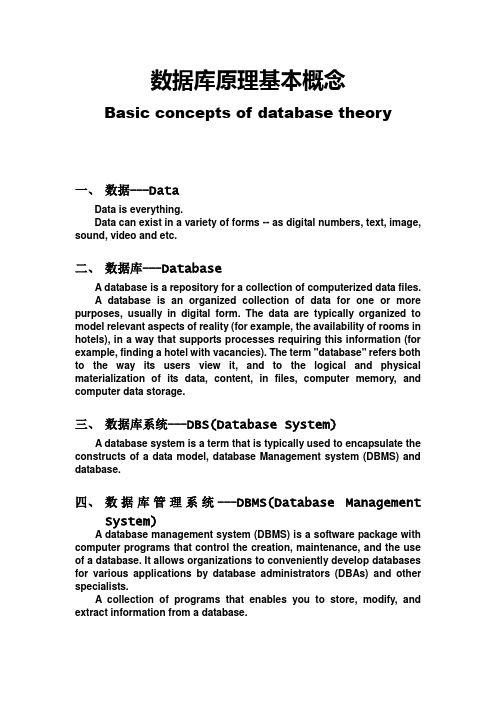
数据库原理基本概念Basic concepts of database theory一、数据---DataData is everything.Data can exist in a variety of forms -- as digital numbers, text, image, sound, video and etc.二、数据库---DatabaseA database is a repository for a collection of computerized data files.A database is an organized collection of data for one or more purposes, usually in digital form. The data are typically organized to model relevant aspects of reality (for example, the availability of rooms in hotels), in a way that supports processes requiring this information (for example, finding a hotel with vacancies). The term "database" refers both to the way its users view it, and to the logical and physical materialization of its data, content, in files, computer memory, and computer data storage.三、数据库系统---DBS(Database System)A database system is a term that is typically used to encapsulate the constructs of a data model, database Management system (DBMS) and database.四、数据库管理系统---DBMS(Database ManagementSystem)A database management system (DBMS) is a software package with computer programs that control the creation, maintenance, and the use of a database. It allows organizations to conveniently develop databases for various applications by database administrators (DBAs) and other specialists.A collection of programs that enables you to store, modify, and extract information from a database.五、数据库管理员---DBA(Database Administrator)A database administrator is a person responsible for the design, implementation, maintenance and repair of an organization's database.六、模式---SchemaA database schema of a database system is its structure described in a formal language supported by the database management system (DBMS) and refers to the organization of data to create a blueprint of how a database will be constructed.In other words, schema is the structure of the database that defines the objects in the database.七、内模式---Internal SchemaInternal Schema: storage schema– Describes how data is stored and what the physical structureof data is.– Totally dependent on particular implementation.– There is only one internal schema in a DB.八、外模式---External SchemaExternal Schema: user schema or subschema– Interface between users and DBS– Describes the logical structure of some local data oriented tosome applications and users– There may be many external schemata in a DB.九、三级模式---Three Levels of Schema-Physical level: describes how a record (e.g., customer) is stored.-Logical level: describes data stored in database, and therelationships among the data.-View level: application programs hide details of data types. Views can also hide information (such as an e mployee’s salary)for security purposes.十、映像---MappingData mapping is the process of creating data element mappings between two distinct data models. Data mapping is used as a first step for a wide variety of data integration tasks including:●Data transformation or data mediation between a data source anda destination●Identification of data relationships as part of data lineageanalysis●Discovery of hidden sensitive data such as the last four digitssocial security number hidden in another user id as part of a datamasking or de-identification project●Consolidation of multiple databases into a single data base andidentifying redundant columns of data for consolidation orelimination十一、逻辑独立性---Logical Independence When schema changes (e.g., new relation/new attribute added), DBA changes the Ex-schema/schema mapping, so the external schema can stay unchanged, i.e. applications needn’t be changed.十二、物理独立性---Physical Independence When internal schema changes ,DBA changes the schema/internal schema mapping, so the schema can stay unchanged . Thus, the external schema also keeps the same.十三、数据模型---Data ModelA data model in software engineering is an abstract model, that documents and organizes the business data for communication between team members and is used as a plan for developing applications, specifically how data is stored and accessed.A data model can be sometimes referred to as a data structure, especially in the context of programming languages. Data models are often complemented by function models, especially in the context of enterprise models.。
数据库原理 英文

数据库原理英文Database PrinciplesIntroduction:Database principles are fundamental concepts that govern the design, management, and use of databases. A database is a structured collection of data that is organized and stored in a manner that allows for efficient retrieval, manipulation, and analysis.Data Models:Data models are used to represent how data is organized and structured within a database. These models determine the relationships between data elements and define the rules for how data is stored and manipulated. Common data models include hierarchical, network, relational, and object-oriented.Relational Model:The relational model is the most widely used data model in modern databases. It organizes data into relations, which are tables with rows and columns. Each row represents a record, and each column represents a characteristic or attribute of that record. Relationships between tables are established through primary keys and foreign keys.Normalization:Normalization is the process of designing database tables to reduce redundancy and improve data integrity. It involves breaking down large tables into smaller ones and creating relationships between them. The goal is to eliminate data anomalies and ensure that eachpiece of data is stored in one place only.Query Languages:Query languages allow users to retrieve, manipulate, and update data in a database. The most common query language is Structured Query Language (SQL), which is used to interact with relational databases. SQL provides a set of commands and functions that enable users to perform operations such as data retrieval, insertion, deletion, and modification.Indexing and Query Optimization:Indexes are data structures that improve the speed of data retrieval operations. They provide a way to locate data quickly based on specific criteria. Query optimization involves analyzing and rearranging queries to execute them in the most efficient way possible. Techniques such as storing intermediate results, using parallel processing, and selecting appropriate indexing strategies are commonly employed.Transaction Management:A transaction is a unit of work that consists of one or more operations performed on a database. Transaction management ensures the atomicity, consistency, isolation, and durability of database operations. Transactions are usually managed by a database management system (DBMS) through the use of transaction logs and concurrency control mechanisms. Concurrency Control:Concurrency control prevents conflicts when multiple users try to access or modify the same data simultaneously. Techniques suchas locking, timestamping, and optimistic concurrency control are used to manage concurrent access and ensure data consistency. Backup and Recovery:Backup and recovery involve creating copies of a database to protect against data loss and ensuring that data can be restored in the event of a failure. Backups can be performed at different levels (database, table, or file) and can be either full or incremental. Recovery mechanisms restore the database to a consistent state after a failure, using backup copies and transaction logs. Conclusion:Understanding database principles is essential for designing efficient and robust databases. Data modeling, normalization, query languages, indexing, transaction management, concurrency control, and backup and recovery are key concepts that form the foundation of database systems. By applying these principles, database professionals can optimize data storage, retrieval, and manipulation, leading to better performance and data integrity.。
数据库系统原理(英文)-Syllabus for Database System Principles

Beijing University of Posts and Telecommunications (BUPT)School of Computer Science and Technology Syllabus for Database System Principles 1. OverviewsCourse No.:323•04105Course Title:Database System Principles Course Credit: 3 Credits, required courseSemester and Year: Spring 2007Class: 04411—04415Teaching hours:●Class teaching: 51 hours●After-class experiments: 17 hours●Course design, or professional practice for this course:(数据库系统综合课程设计), 30 hours, 1 credits,conducted in the 3rd semester.Prerequisites:●Data Structures●Discrete Mathematics●Operating Systems●Algorithms Design and Analysis2. Lecture MeetingsTime: Tuseday AM: 8:00 – 10:00Friday AM: 8:00 – 10:00, only odd weeksLocation: Room 539, 3th Teaching Building3. FacultyInstructor●Name: Dr. Wen YE (叶文)●Office: Room 918, 3rd Teaching Building●Office Hours: Wednesday 3:00 to 4:30 PM,I am also available by appointment at a time more convenientfor you, especially at the end of this semester●Phone: 86-10-62282633 (O)●E-mail: gryew@, yewen@Experiments Directors:●Name: ???●Responsibility: directing experiments●Office: Room 913, Main Building●Office Hours: Friday 14:00 to 17:00 PM, or by appointmentGraduate Teaching Assistant:●Name: ?? ( )●Responsibility: checking homework●Office: Room 918, 3rd Teaching Building●Office Hours: Wednesday 13:30 to 15:00 PM, or by appointment●E-mail:4. Text Book1. Abraham Silberschatz, Henry F.Korth, S. Sudarshan, Database System Concepts(Forth Edition, Fifth Edition), Higher Education Press and McGraw-Hill Companies, Beijing, May, 2002. References1.中国计算机科学与技术学科教程2002研究组,中国计算机科学与技术学科教程2002,清华大学出版社,北京,2002年8月。
数据库原理与应用的英文

Database Principles and Applications IntroductionThe purpose of this document is to provide an overview of database principles and their applications. The document will discuss the fundamental concepts of databases, including data models, relational databases, and various database management systems. It will also explore the practical applications of databases in different industries and highlight their significance in modern data-driven environments.Table of Contents1.Data Models2.Relational Databases3.Database Management Systems4.Database Applications5.Conclusion1. Data ModelsData models serve as the foundation for organizing and representing data in a structured manner. They define the structure, relationships, and constraints of the data. There are several types of data models, including:•Hierarchical Model: Represents data in a tree-like structure with parent-child relationships.•Network Model: Represents data using a graph structure, allowing more complex relationships.•Relational Model: Represents data as tables or relations, with rows and columns.•Object-Oriented Model: Represents data as objects, with attributes and methods.•Entity-Relationship Model: Represents data using entities, attributes, and relationships.2. Relational DatabasesRelational databases are based on the relational model, which organizes data into tables, each with its own columns and rows. The relationships between tables are defined using primary and foreign keys. Key concepts in relational databases include:•Tables: Organized collections of data, with each column representinga specific attribute and each row representing a record.•Primary Key: A unique identifier for each record in a table.•Foreign Key: A field in one table that refers to the primary key in another table, establishing a relationship between the two.•Normalization: The process of organizing data to eliminate redundancy and improve data integrity.•SQL: Structured Query Language used for managing and querying relational databases.3. Database Management SystemsA Database Management System (DBMS) is software that allows users to create, manage, and manipulate databases. It provides an interface to interact with the underlying database and includes features such as:•Data Definition Language (DDL): Allows users to create, modify, and delete database structures, tables, and constraints.•Data Manipulation Language (DML): Enables users to insert, update, delete, and retrieve data from a database.•Transaction Management: Ensures the integrity and consistency of database operations.•Security: Provides mechanisms for authentication, authorization, and access control.•Query Optimization: Automatically optimizes queries for better performance.Some popular DBMSs include Oracle, MySQL, Microsoft SQL Server, and PostgreSQL.4. Database ApplicationsDatabases have various applications across industries, playing a crucial role in managing and analyzing large amounts of data. Here are a few examples of database applications:•E-commerce: Databases are used to store product information, customer data, and manage orders.•Healthcare: Databases store patient records, medical history, and facilitate efficient healthcare management.•Finance: Databases are used for storing financial transactions, managing accounts, and processing payments.•Education: Databases manage student records, course information, and enable online learning platforms.•Logistics: Databases help in tracking inventory, managing supply chains, and optimizing logistics operations.The applications of databases are diverse and extend to almost every industry that deals with data management and analysis.ConclusionDatabase principles and applications are essential in modern data-driven environments. Understanding data models, relational databases, and database management systems is crucial for effective data organization and retrieval. The practical applications of databases span across industries and demonstrate their significance in today’s digital world. By leveraging databases, organizations can efficiently manage and analyze vast amounts of data, enabling informed decision-making and improving overall efficiency.。
数据库系统原理(英文)-12-11

hash indices
B, b1 b2 b3 … bi … bj … bm … bn S, …. , , D) s1 … d 1 s2 s3 … si … sj … sm … sn … … … … … … … … … … … d2 d3 … di … dj … dm … dn-1 dn h(si) … 散列 函数H h(s1) s1 s2 s3 . . si . . sj . sn 搜索键 (search key)
May 2011
Database System Concepts - Chapter 12 Indexing and Hashing -
8
§12.2 Ordered Indices
DBS file with indexing mechanism include two parts : indexed file, in which data records are stored index file, in which index entries are included e.g. Fig.12.1 The indexed file can be organized as sequential file heap file hash file clustering file
May 2011
Database System Concepts - Chapter 12 Indexing and Hashing -
3
§12.1 Basic Concepts
How to locate records in DB file quickly? Indexing (索引技术) mechanisms used to speed up access to desired data e.g. for relation account(account-number, branch-name, balance) shown in Fig.12.1, the index branch-name physical address of record (i.e.tuple) in DB file account Search Key attributes or a set of attributes used to look up the records in a file e.g. branch-name
数据库系统原理PrinciplesofDatabaseSystem
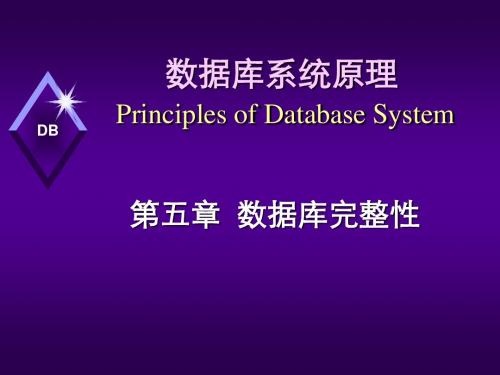
完整性:能否真实地反映现实世界
数据的完整性和安全性是两个不同概念
DB
数据的完整性
防止数据库中存在不符合语义的数据,也就 是防止数据库中存在不正确的数据 防范对象:不合语义的、不正确的数据
数据的安全性
保护数据库防止恶意的破坏和非法的存取
防范对象:非法用户和非法操作
第五章
DB
数据库完整性
为维护数据库的完整性,DBMS 必须提供一种机
取值不空且唯一,部门编号Deptno 列为主码。 CREATE TABLE DEPT (Deptno CHAR(2) PRIMARY KEY, Dname CHAR(10) UNIQUE NOT NULL ,
5.1.2 实体完整性检查和违约处理
DB
索引
新插入记录 的主码值: 25 新插入记录 的主码值: 86
B+树索引
5.1.2 实体完整性检查和违约处理
DB
检查记录中主码值是否唯一的一种方法是进行全表
扫描。
全表扫描是非常耗时的。为了避免对基本表进行全 表扫描,RDBMS一般都在主码上自动建立一个索引 SQL Server在自动在主码上建立聚族索引 通过索引查找基本表中是否已经存在新的主码值, 将大大提高效率。
DB
5.3 用户定义的完整性
5.3.1 属性上的约束条件的定义 5.3.2 属性上的约束条件检查和违约处理 5.3.3 元组上的约束条件的定义
5.3.4 元组上的约束条件检查和违约处理
5.3.1 属性上的约束条件的定义
DB
在CREATE TABLE中定义属性的同时可以根据具体
的应用要求,定义属性上的约束条件,即属性取值的
例4 在创建选课基本表时,显式地说明参
数据库系统原理(英文)-3-09数据库设计和e - r模型

3.2.2 Schema Definition (cont.)
An SQL relation is defined using the create table command create table r (A1 D1, A2 D2, ..., An Dn, (integrity-constraint1), ..., (integrity-constraintk)) r is the name of the relation each Ai is an attribute name in the schema of relation r Di is the data type of values in the domain of attribute Ai The most important integrity constraint is the primary-key specification primary key (Aj1, Aj2, …, Ajm)
DDL in SQL allows the specification of information about each relation, including the schema for each relation or view -----create table/view the domain of values associated with each attribute integrity constraints the set of indices to be maintained for each relations security and authorization information for each relation the physical storage structure of each relation on disk
数据库系统原理(英文)-6

6.2.1 Entity Sets (cont.)
A entity consists of all values of its all attributes e.g. Fig 6.1 Entity-set customer-set = {< ID-value, name-value, street - value, city -value> | ID-value ∈D1, name-value ∈D2, street -value∈D3, city -value D4} ⊆ D1 ╳ D2 ╳ D3 ╳ D4
603dbas生命周期模型需求分析概念设计逻辑设计物理设计性能存储安全需求数据项分析数据流与事务分析程序需求分析程序概要设计程序详细设计系统总体设计数据访问与处理应用程序数据组织与存储系统运行维护设计db概念模式设计db逻辑模式设计系统实现和部署事务详细设计db物理模式设计事务概要设计构造原型可选系统实现数据转换与加载系统测试部署与交付规划与分析项目规划运行维护中国移动网管支撑系统规范cmoss20性能指标要求621entitysets实体集实体型conceptualdatabasecanrelationshipamongentities
6.1 Overview of the Design Process (cont.)
数据库应用系统DBAS设计 DB, DBMS, users, application programs refer to Fig. 6.0.2 电信网管系统示意图 DBAS设计 refer to Fig. 6.0.3 DBAS 生命周期模型 参照软件工程中软件开发瀑布模型原理,DBAS的生命周 期由项目规划、需求分析、系统设计、实现与部署、运行 管理与维护等5个基本活动组成 根据DBAS的软件组成和各自功能,分为数据组织与存储 设计、数据访问与处理设计、应用设计三条设计主线,分 别用于设计数据库、数据库事务和应用程序
